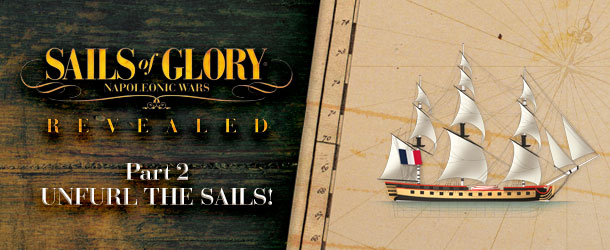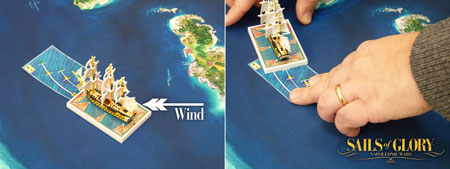Captain James Gambier scowled across the water at the signal flags flying from Admiral Graves’ Royal Sovereign. Rather than Follow Ahead, the typical maneuver one expected to break the French line, Admiral Graves was signaling for the Squadron to Engage the Enemy – to turn and close with the ships closest to him – passing between them and racking both. This was a dangerous maneuver – all the British ships would be subject to the full weight of the French fleet’s broadsides as they closed. Gambier lower his glass and scowled even more deeply, and shouted the order – Engage the Enemy! HMS Defense heeled over, her sails snapped, and she darted forward to split Le Mucius and Le Tourville – it is a Glorious First of June, thought Gambier, as he saw the smoke and flames of the French broadside – I’ll be the first to crack their lines, or I’ll die trying!
Sails of Glory is designed to allow you to recreate exciting engagements, like HMS Defense’s heroic engagement of Le Mucius and Le Tourville on The Glorious First of June, with minimum interference from game mechanics, making play fast-paced and action-packed. The Rules are presented in three progressive realism levels: Basic Rules - the easiest, introductory level that permits you to begin playing in minutes, and two more advanced levels that add realism and options without detracting from speed of play, for you to add as you become familiar with the basic mechanics.
Sails of Glory requires at least two players, with each controlling at least one ship (it can be played with multiple players, and each player can control multiple ships). To begin play, each player takes a Ship Figure, a Ship Log, a Ship Card, and the appropriate set of Maneuver Cards. There are 4 sets of maneuver cards included with the game (Lettered A-D), and each ship has a maneuver rating that determines which deck it will use.
The wind is, of course, an important factor is sailing, and in Sails of Glory. In the basic game, the wind has a fixed direction, to make things easier for new Captains. To keep track of this direction, the players have at their disposal the wind indicator, placed on a side of the gaming table with its arrow indicating the direction of the wind. In the advanced rules, the wind may shift, allowing for more engaging and realistic battles!
In Sails of Glory, the game turn is composed of four phases: Planning, Movement, Combat and Reloading. Players perform each of these phases simultaneously with each other player, increasing the pace of the game. In this article, we will explore the first two phases – Planning and Movement – in the Basic Game.
Planning
1 Assess the attitude to wind of the ship. The player places an attitude measurer beside the ship, in the same direction shown by the wind indicator on the table, so that the tip of the measurer touches the main mast of the ship. The player simply observes the color of the edge of the Ship’s Base where it is crossed by the attitude measurer. The color determines whether the ship is beating/running (Orange) reaching (Green) or taken aback (Red).

Attitude to the Wind
(1) Red: Taken Aback; (2) Orange: Beating; (3) Green: Reaching; (4) Orange: Running
2 The player then selects a Maneuver Card from his Maneuver Deck. If his ship is beating/running, or reaching, the Player may select any normal maneuver card (with a blue border) to plan the movement of the ship. If the ship is taken aback, the player may only use a maneuver card with a red border to plan the movement. The player places the selected Maneuver Card on his Ship Log, face down. This ends the Planning Phase.

When the ship is taken aback, a red border maneuver card is used - the arrow with two sandglasses in the basic game.

A normal maneuver card is placed in the front of the ship. The middle arrow is used in the basic game.
Moving
When all players have planned their maneuvers, they reveal their maneuver cards at the same time, and move their ships.
To move their ships, the player takes the Maneuver Card and places it on the table with his Ship. Normal maneuver cards are placed in the front of the ship, while Red Bordered Maneuver Cards (for those ships taken aback) are placed to the rear of the ship.
Normal Maneuver Cards have three different Movement Lines on them – representing the ship’s movement under Battle Sails, Full Sails or Backing Sails. Only the Movement Lines for Battle Sails is used in the basic game. Each Movement Line has two Movement Arrows on it – an Orange Movement Arrow, for beating/running ships, and a Green Movement Arrow, for ships that are reaching.
To Move his ship, the player simply takes the base of his Ship and moves it onto the maneuver card, so that the black arrow on the back of the Ship Base aligns with either the Green Movement Arrow or the Orange Movement Arrow, depending on the attitude of the ship.
When the ship is taken aback (the base color matching the wind attitude measurer is red), the player must use a movement card with a red border. Each red Maneuver Card has two movement lines – one with One Hourglass and one with Two Hourglasses. In the Basic Game, only the Movement Line with Two Hourglasses is used. The Maneuver Card is placed with the arrow to the rear of the ship base, rather than to the front, showing the backing action of the wind.

The ship is taken aback, so it uses a red-bordered maneuver card, and moves backward using the arrow with two hourglasses.
After the ship has been moved, the maneuver card is placed back in your maneuver deck. During the game, you have to pay attention to your movements - If any part of a ship base exits the game field after a maneuver, the ship is eliminated and counts as surrendered.
Maneuvering your ship in the best position is an essential part of your tactics – In the next article, we will see how the combat system works, and what you should try to achieve when moving.
See also:
Sails of Glory Preview - Part 1: Introduction
Sails of Glory Preview - Part 3: Fire!
Sails of Glory Preview - Part 4: The Standard Rules











Follow Us on